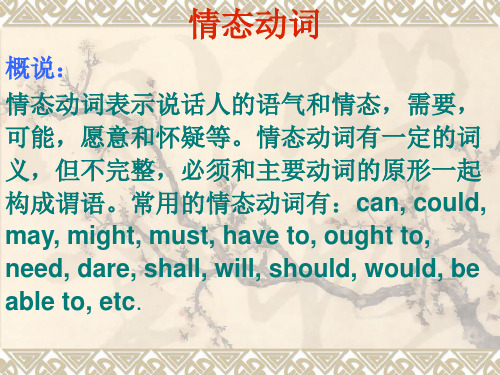英语语法副词PPT课件
合集下载
初中英语语法课件-副词的基本用法

频度副词
usually 通常 never 从来不 ever 曾经
often 经常 sometimes 有时 always 总是 hardly 几乎不 rarely 极少 seldom 极少
疑问副词
how 怎样
when 什么时候 where 哪里
why 为什么 how 如何
how long 多长
how often 多久一次 how far 多远
4. 副词修饰基数词时,通常放在被修饰基数词的前面。 Her grandpa is over eighty, but he is healthy. 她的爷爷八十多岁了,但是很健康。
1. The night was very ___, so he had to take off
his shoes ___.
2. 副词修饰形容词时,通常放在该形容词的前面。 He is a very funny boy. 他是一个非常有趣的男孩。 The boy is too young. He can’t carry the heavy box. 这个男孩太小。他搬不动这个重箱子
3. 副词修饰其它副词时,通常放在被修饰副词的前面。 The girl swims very well. 这个女孩游泳游地得非常好。 He works very hard. 他工作非常努力。
4. How ___ the girls are playing! A. happy B. happier C. happyly D. happily
THE END
A. quiet; quietly B. quite; quickly
C. late; quick
D. quite; quietly
2. I saw the film two days ___. A. ago B. before C. after D. late
副词-专升本英语语法详细讲解课件

意。
Have you been there already?
③做“还”讲时, yet用于否定句, still用于肯定 句、疑问句, 表示“依然、继续”, 有时也用于 否定句。
The rain hasn’t stopped yet.
It’s still raining now.
四.同源副词
A)
5.I used to smoke _______ but I gave it up three years ago.
A) seriously B) heavily C) badly D) severely
B)
6.The organization had broken no rules, but _____ had it acted responsibly. A) neither B) so
A) essentially B) completely C) necessarily D) remarkably
A)
3.Our journey was slow because the train stopped ________ at different villages.
A) unceasingly B) gradually C) continuously D) continually
4.so, neither与nor
三个词都能表示后者和前者情况相似。 so用于肯定句, neither和nor用于否定 句。
①He likes skating. So do I. ②The first one wasn't good, and
neither/nor was the second.
2. late, lately late意思是“晚”, lately意思为“近来” You have come too late. Have you see him lately?
Have you been there already?
③做“还”讲时, yet用于否定句, still用于肯定 句、疑问句, 表示“依然、继续”, 有时也用于 否定句。
The rain hasn’t stopped yet.
It’s still raining now.
四.同源副词
A)
5.I used to smoke _______ but I gave it up three years ago.
A) seriously B) heavily C) badly D) severely
B)
6.The organization had broken no rules, but _____ had it acted responsibly. A) neither B) so
A) essentially B) completely C) necessarily D) remarkably
A)
3.Our journey was slow because the train stopped ________ at different villages.
A) unceasingly B) gradually C) continuously D) continually
4.so, neither与nor
三个词都能表示后者和前者情况相似。 so用于肯定句, neither和nor用于否定 句。
①He likes skating. So do I. ②The first one wasn't good, and
neither/nor was the second.
2. late, lately late意思是“晚”, lately意思为“近来” You have come too late. Have you see him lately?
初中英语语法——形容词和副词-精(共18张)ppt课件

3
作定语,放在名词之前,不定代词之后
完整最新ppt
4
n ...的人 -al 有...属性的
-ful ...的
-y 充满...的,多...的 -ern ...方位的 -less 无...的
完整最新ppt
-en ...材质的 -able 可能的,可以的
5
副词是一种用来修饰动词,形容 词,副词或全句的词,说明时间,地点, 程度,方式等概念。
比较级
more slowly more quickly more angrily more softly more noisily
最高级
most slowly most quickly most angrily most softly most noisily
由ing分词和ed分词演变过来的形容词(包括不规 则动词如know→known)只能加more或most来表
more更多的;更
less更少的 farther更远的;更远地
further进一步的(地)
most最多的;最
least最少的 farthest最远的;最远地
furthest最深刻的(地)
完整最新ppt
15
①表示两者进行比较时用形容词比较级,其结构为“A…+比较级+ than+B”。 ②有表示程度的副词a little, a bit, a few, a lot, much, even, still, far, rather, any等修饰时,用形容词比较级。 ③表示两者之间进行选择“哪一个更……”时,用句型“Which/ Who is +形容词比较级,A or B?”表示。 ④表示“几倍于……”时,用“倍数+ 比较级+ than”表示。 ⑤表示“两者之间最……一个(of the two)”时,常用“the+比较级”结构。 ⑥表示“越来越……”,用比较级重叠结构,即“比较级+ and +比较级”,多音节词和部分双音节词时用“more and more +形容词原级” ⑦表示“越……就越……”时,用“the+比较级,the+比较级”结构。 ⑧在两者进行比较“表示A不如B”时,部分双音节和多音节副词除使用“not…as/ so +副词原级+as”结构外, 还可使用“less +副词原级+than”结构。 ⑨副词最高级前一般不加定冠词the。
作定语,放在名词之前,不定代词之后
完整最新ppt
4
n ...的人 -al 有...属性的
-ful ...的
-y 充满...的,多...的 -ern ...方位的 -less 无...的
完整最新ppt
-en ...材质的 -able 可能的,可以的
5
副词是一种用来修饰动词,形容 词,副词或全句的词,说明时间,地点, 程度,方式等概念。
比较级
more slowly more quickly more angrily more softly more noisily
最高级
most slowly most quickly most angrily most softly most noisily
由ing分词和ed分词演变过来的形容词(包括不规 则动词如know→known)只能加more或most来表
more更多的;更
less更少的 farther更远的;更远地
further进一步的(地)
most最多的;最
least最少的 farthest最远的;最远地
furthest最深刻的(地)
完整最新ppt
15
①表示两者进行比较时用形容词比较级,其结构为“A…+比较级+ than+B”。 ②有表示程度的副词a little, a bit, a few, a lot, much, even, still, far, rather, any等修饰时,用形容词比较级。 ③表示两者之间进行选择“哪一个更……”时,用句型“Which/ Who is +形容词比较级,A or B?”表示。 ④表示“几倍于……”时,用“倍数+ 比较级+ than”表示。 ⑤表示“两者之间最……一个(of the two)”时,常用“the+比较级”结构。 ⑥表示“越来越……”,用比较级重叠结构,即“比较级+ and +比较级”,多音节词和部分双音节词时用“more and more +形容词原级” ⑦表示“越……就越……”时,用“the+比较级,the+比较级”结构。 ⑧在两者进行比较“表示A不如B”时,部分双音节和多音节副词除使用“not…as/ so +副词原级+as”结构外, 还可使用“less +副词原级+than”结构。 ⑨副词最高级前一般不加定冠词the。
初中英语语法—形容词、副词PPT课件

2. Don’t worry. There is __C__ about your illness.
A.serious something B. anything serious
C. nothing serious D. some thing
3.There is __C__ in today’s newspaper. It’s boring.
1.Is there anything interesting in today’s newspaper ?
2. I have something important to tell you.
-
7
1. Sam is hungry, he’d like to eat _C___delicious.
A. some B. any C. something D. somewhere
The windows of our classroom are cleaner than those of theirs.
-
23
1、as+形容词原形+as
Tom is as tall as Mike.
There are as many students in our
school as yours.
3、… too+原级+ to do sth.
He is too young to join the army.
4、形容词原级+ enough to do sth.
This truck is big enough to carry 5 tons.
-
25
1、两者之间的比较,句中有明显的标志词than
Tom is taller than John
2025届高考英语语法总复习形容词副词课件

however然而,otherwise否则,though尽管,yet虽然,instead相 反 besides而且,moreover而且,still还是,furthermore而且
表结果
therefore因此,thus因而
表让步
anyway不管怎样,无论如何
George didn’t study law.Instead,he decided to become an actor.
friend朋友→friendly友好的;time时间→timely 名词/动词
有……特征的 及时的;day一天→daily日常的;love爱→lovely
构成 意义
例词
end终止→endless无穷无尽的;aim目标→aimless无目 名词/动词 没有……
标的;home家→homeless无家可归的;use使用 +-less 的
形容词有时也作状语,通常说明主语的情况,主要表示原因、 结果、伴随、时间、条件或方式,可位于句首、句中或句末, 一般用逗号将其与其余部分隔开。
Hot and wet,you couldn’t imagine the climate here in summer.
又热又潮湿,你根本无法想象这儿的夏天(形容词作状语,表示原因)
……的 →comfortable舒适的;admire钦佩→admirable
able
可钦佩的
attract吸引→attractive有吸引力的;create创造 名词/动词
有……性质的 →creative创造性的;expense花费→expensive +-ive
昂贵的;effect效应→effective有效的
比较级、最高级的变化规则分为规则变化和不规则变化
高中英语语法:形容词和副词(共61张PPT)

一、形容词和副词的句法功能
1.作定语 形容词作定语一般位于被修饰词的前面;副词作定语多表示时间 或地点,位于被修饰词的后面。 Widespread poverty in Africa means that many people there cannot get the water, clothing, housing, electricity, or education they need.非 洲普遍的贫穷意味着那里的许多人不能获得他们需要的饮用水、 衣服、房屋、电力及教育。 The people there were friendly.那儿的人很友好。(副词作定语须 后置)
the English英国人
(2)“the+形容词”表示抽象概念,作主语时谓语动词用单数。
the best最好的情况
the unknown未知的事
the impossible不可能的事
the right正确的事
二、形容词和副词的位置
1.形容词的位置 (1)一般情况下,单个形容词都位于所修饰的名词前。
一二、介 形词 容的 词分 和类副词的位置
(3)形容词也可位于被修饰名词之后。
③两个意义相近或相反的形容词用and, or或but连接,作定语时须后 置。 Power stations, large or small, have been set up all over the country.大大 小小的发电站已经在全国建立起来了。 All the people on this island, young or old, are fond of music.这个岛上的 老老少少都喜欢音乐。(意义相反。) ④当“形容词+不定式”构成的短语作定语时。 A man so difficult to please must be hard to work with.一个如此难以取悦 的人一定很难共事。 He enjoys the music pleasant to listen to.他很喜欢这首听起来很好听的 音乐。
英语语法---副词课件

angry生气的
angrily生气地
heavy重的
heavily重地
2.以辅音字母+y结尾的形 容词,变“y”为i再加ly.
3.奇葩一朵朵
形容词
副词
good好的
well好地
true真实的
truly真实地
terrible恐怖的 terribly恐怖地
well健康的
她唱歌唱得很恐怖!
She sings terribly.
英语副词
目录
DIRECTORY
01 副词分类&用法 02 副词级别
01 副词分类&用法
概念
表示行为特征或性状特征的词。用来修饰动词、形容 词、其它副词、全句或名词词组及句子的词。 e.g. ①He has got a serious illness.(名词)
②He is seriously ill.(形容词) ③ You can find books on that subject
常用副词
1.too“也”用于肯定句,可放在句中,也可放在句末。
Xiao Li went to Beijing and Xiao Zhao, too, went to Beijing.
小李到北京去了,小赵也到北京去了。
He studies hard and I study hard, too.
他学习用功,我(学习)也用功。
副词
deeply深深地
deep意思是“深”,表示时间和空间深度; deeply时常表示感情上的深度,"深深地" This lake is very deep. He went deep into the water. He often works deep into the night. Even father was deeply moved by the film.
形容词和副词英语语法讲解PPT

• 4.与定冠词一起表示某一类人或物, 如: • The rich and the poor live very different lives . • 5.作状语,表示伴随、原因、结果等。如: • He went to bed , cold and hungry .
二、副词
• (一)副词的作用 • 1.作状语,修饰动词、形容词、副词或整 个句子。如: • He had worked hard all his life .(修饰动词) • He is very diligent.(修饰形容词) • You can find books on that subject quite easily .(修饰副词) • Luckily she was in when I called .(修饰句 子)
C. “enough”作定语时一般放在中心词前;但作 副词时只能后置。 We have enough food to eat. She is old enough to go to school. D. 以 a- 开头的形容词做定语要后置。如:alike, alive, alone, asleep, afraid, awake… 如:He is the only man awake at that time. E. 某些形容词,如: present (在场的,出席的), involved(有关的), concerned (相关的), left (剩下 的), mentioned (提及的), selected (当选的)等。 如: the students present (出席的学生) the cost involved (所需费用)
beautifully She is always dressed ____________. 2. 形容词修饰名词;副词修饰形容词,副词和全句。 He has got a serious illness.(名词) He is seriously ill.(形容词) You can find books on that subject quite easily .(副词) Luckily she was in when I called.(句子)
英语语法形容词和副词课件PPT

语法互动(六)┃形容词和副词
(3)“比较级+and+比较级”表示“越来越……”。 He is getting _t_a_ll_e_r_a_n_d__ta_l_le_r_.他越来越高了。 He does his homework more and more carefully. 他做作业越来越认真了。 (4)“the+比较级,the+比较级”表示“越……,就越……”。 _T__h_e_h_a_r_d_e_r_ you work,___th_e__b_e_tt_e_r__ your grades will be. 你越努力学习,你的成绩就会越好。 (5)“特殊疑问词+v.+比较级,A or B?” Which is bigger, the blue ball or the red one? 哪一个球更大,蓝球还是红球? [注意] 比较级前常用much, even, a little, a bit, a lot, far等词修饰。
语法互动(六)┃形容词和副词
考点四 形容词和副词比较等级的用法 1.原级的用法 (1)只能修饰原级的词有very, really, quite, so, too等。 The old man is __to_o__ti_r_e_d_t_o__ walk on. 那位老人太累了不能再继续走了。
语法互动(六)┃形容词和副词
语法互动(六)┃形容词和副词
④“基数词-单数可数名词-形容词”为复合形容词, 放
在被修饰的名词前面。 Tom is an eight-year-old boy. 汤姆是一个八岁的小男孩。 (2)形容词作表语时,与连系动词构成系表结构。 The meal is delicious. 这顿饭很美味。 (3)形容词作宾语补足语时,用来说明宾语的性质、状态 或特征。 I found the book interesting. 我发现这本书很有趣。
小学英语语法课件-副词比较等级的用法 (共35张PPT) 全国通用

Are you listening to me carelessly? No, we aren’t. We’re listening to you carefully. 指着另一个孩子 Is Jack listening to Vicky carefully? Yes, he is.
Is Mary listening to Vicky carefully? Yes, she is.
Yes, she is.
most clearly 副词比较级+and+副词比较级,表示“越来越……”。 读一读下列句子,请将句子中的副词比较级划线
more happily
Presentation
Sentences
※of和in在短语中的区别:“of+复数”表示“在……之中(的)”;
Who runs faster, Tim or Tom?
Practice Oral Practice
说出下面副词的比较级与最高级
well far suddenly healthily lately happily frequently
better further more suddenly more healthily more lately more happily more frequently
So we can say Mary is listening to Vicky as carefully as Jack.
Warm up
今天我们来学习副词比较等级的用法。副词的原级用于 两者之间的比较,表示“相似,相同”。副词比较级用于两 者之间的比较,表示“两者之间较……的”。副词的最高级 用于三者或三者以上的比较,表示“三者或三者以上中 最……的”。
《英语语法大全》PPT课件

04
(6)介词—副词 ,如:in(到……里)—(在里面;在家 ),on(在…上)—(进行 ,继续),等等
05
谢谢
2、派生法:
1)派生名词:
●动词 +er/or
●动词 +ing
●动词 +(t)ion
●形容词 +ness
●其他 ,如:inventor
learner swimming congratulation kindness
carelessness knowledge
2)派生形容词:
●Chinese; Japanese
07lish
●French
●German
●名词 +y
02
03
01
04
05
●名词 +ful
●dangerous
●动词 +ing/ed
●friendly
●国名 +(i)an 如:snowy sunny hopeful beautiful interesting following
daily(每日的 ) nervous delicious
7、宾语补足语 用来说明宾语怎么样或干什么 ,通常由形容词或动词充当。
如:They usually keep their classroom clean.
他们通常让教室保持清洁。
He often helps me do my lessons.
他常常帮我做功课。
The teacher wanted me to learn French all by myself.
如:He can spell the word.(他能拼这个词 )
有些及物动词带有两个宾语,一个指物 ,一个指人。指物的叫直接宾语,指人的叫间接宾语。间接宾语一般放在直接宾语的前面。 如:He wrote me a letter . (他给我写了一封信 )
(6)介词—副词 ,如:in(到……里)—(在里面;在家 ),on(在…上)—(进行 ,继续),等等
05
谢谢
2、派生法:
1)派生名词:
●动词 +er/or
●动词 +ing
●动词 +(t)ion
●形容词 +ness
●其他 ,如:inventor
learner swimming congratulation kindness
carelessness knowledge
2)派生形容词:
●Chinese; Japanese
07lish
●French
●German
●名词 +y
02
03
01
04
05
●名词 +ful
●dangerous
●动词 +ing/ed
●friendly
●国名 +(i)an 如:snowy sunny hopeful beautiful interesting following
daily(每日的 ) nervous delicious
7、宾语补足语 用来说明宾语怎么样或干什么 ,通常由形容词或动词充当。
如:They usually keep their classroom clean.
他们通常让教室保持清洁。
He often helps me do my lessons.
他常常帮我做功课。
The teacher wanted me to learn French all by myself.
如:He can spell the word.(他能拼这个词 )
有些及物动词带有两个宾语,一个指物 ,一个指人。指物的叫直接宾语,指人的叫间接宾语。间接宾语一般放在直接宾语的前面。 如:He wrote me a letter . (他给我写了一封信 )
英语语法 情态动词和形容词副词.ppt

better not.) ❖ --- May I smoke here? ❖ --- Yes, please. / please don’t.
2) 表示推测,“或许,可能” 表示一件事或许会发生, 一般用在陈述句中。
❖ It may rain tomorrow. ❖ They may not be there today. ❖ Fools may ask questions more than wise men can
三. must, have to, need 1. must 的用法: 1) 表示必须要做的事,意为“必须” ,否定式
表示不应该,不许可禁止等。在回答must的问 句时,不用mustn’t,而用needn’t或don’t have to
❖ I must leave at 9.
❖ We must do everything step by step.
❖ The book must have been written by a woman.
❖ You must have been thinking of something.
2. must与 have to的比较: ❖ 1). have to比较强调客观需要,表示因客观环境或事
态促使而不得不做某事;must强调主观看法,表示主 观上认为有必要做某事。
5) be able to与can 的比较 A) 表示能力时可通用
❖ No one can / is able to do it.
❖ Can you come tonight? /Will you be able to come tonight?
B) be able to可用于任何时态, can只能用在现在时或过 去时( could )中。
2) 表示推测,“或许,可能” 表示一件事或许会发生, 一般用在陈述句中。
❖ It may rain tomorrow. ❖ They may not be there today. ❖ Fools may ask questions more than wise men can
三. must, have to, need 1. must 的用法: 1) 表示必须要做的事,意为“必须” ,否定式
表示不应该,不许可禁止等。在回答must的问 句时,不用mustn’t,而用needn’t或don’t have to
❖ I must leave at 9.
❖ We must do everything step by step.
❖ The book must have been written by a woman.
❖ You must have been thinking of something.
2. must与 have to的比较: ❖ 1). have to比较强调客观需要,表示因客观环境或事
态促使而不得不做某事;must强调主观看法,表示主 观上认为有必要做某事。
5) be able to与can 的比较 A) 表示能力时可通用
❖ No one can / is able to do it.
❖ Can you come tonight? /Will you be able to come tonight?
B) be able to可用于任何时态, can只能用在现在时或过 去时( could )中。
- 1、下载文档前请自行甄别文档内容的完整性,平台不提供额外的编辑、内容补充、找答案等附加服务。
- 2、"仅部分预览"的文档,不可在线预览部分如存在完整性等问题,可反馈申请退款(可完整预览的文档不适用该条件!)。
- 3、如文档侵犯您的权益,请联系客服反馈,我们会尽快为您处理(人工客服工作时间:9:00-18:30)。
Set up safety production leading group and provide Party A with copies of job certificate, operation certificate and ID card of the responsible person on site, safety responsible person and all employees. Party B shall be responsible for the personal safety, construction equipment, living facilities, mechanical and electrical equipment and construction safety of Party B.
1.表示地点的副词 Here,there,home,somewhere, everywhere,elsewhere
2.表示位置关系的adv. Above,over,blow,down,up,around, outside
Ⅳ.方式副词一般都是用来描绘动作的,其 中绝大部分是由形容词词尾-ly构成
Anxiously,badly,bravely,fluently,properly, rapidly,sadly,slowly,mildly,suddenly
• 此外副词还可以用作 Set up safety production leading group and provide Party A with copies of job certificate, operation certificate and ID card of the responsible person on site, safety responsible person and all employees. Party B shall be responsible for the personal safety, construction equipment, living facilities, mechanical and electrical equipment and construction safety of Party B. 1.表语 Mary was down with fever.玛丽发烧了。
1.主语从句
When she will be back depends on the weather.
It was a mystery how she got well so soon.
2.宾语从句
They didn’t say where they were to stay.
Nobody can tell why he refused to come. 3.表语从句
等
Ⅲ.地点副词可分为 Set up safety production leading group and provide Party A with copies of job certificate, operation certificate and ID card of the responsible person on site, safety responsible person and all employees. Party B shall be responsible for the personal safety, construction equipment, living facilities, mechanical and electrical equipment and construction safety of Party B.
Ⅴ.程度副词:Much,(a)little,a bit,very,so,too,enough,quite,rather,pretty,fairly,ex tremely等
Ⅵ.疑问副词:how,where,when,why等都用来引起 特殊问句
How are you doing at school?
Where shall we stay for the night? How还可以与许多其他词一起用,如
Set up safety production leading group and provide Party A with copies of job certificate, operation certificate and ID card of the responsible person on site, safety responsible person and all employees. Party B shall be responsible for the personal safety, construction equipment, living facilities, mechanical and electrical equipment and construction safety of Party B.
Ⅸ.其他性质的adv 1.句子副词(对整个句子进行解释说明)
Frankly,are you interested in going?
Seriously,I wish to work there. 另外还有personally,obviously,roughly,
generally,luckily 2.有连接上下文作用的副词 Beside,we have other things to consider.
That was how they overcame the difficult. Ⅷ.关系副词:主要有where,when,why
他们都可以引起定语从句
This is the village where I was born.
Is that the reason why you don’t take the exam?
副词
Set up safety production leading group and provide Party A with copies of job certificate, operation certificate and ID card of the responsible person on site, safety responsible person and all employees. Party B shall be responsible for the personal safety, construction equipment, living facilities, mechanical and electrical equipment and construction safety of Party B.
This,however,is not your fault. 其他如:likewise(同样的),therefore,
lastly,nevertheless
Set up safety production leading group and provide Party A with copies of job certificate, operation certificate and ID card of the responsible person on site, safety responsible person and all employees. Party B shall be responsible for the personal safety, construction equipment, living facilities, mechanical and electrical equipment and construction safety of Party B.
Set up safety production leading group and provide Party A with copies of job certificate, operation certificate and ID card of the responsible person on site, safety responsible person and all employees. Party B shall be responsible for the personal safety, construction equipment, living facilities, mechanical and electrical equipment and construction safety of Party B.
How long have you been there?
How soon is she coming back?
How often do you meet? Ⅶ.连接副词(疑问副词可用来引起从句)
Set up safety production leading group and provide Party A with copies of job certificate, operation certificate and ID card of the responsible person on site, safety responsible person and all employees. Party B shall be responsible for the personal safety, construction equipment, living facilities, mechanical and electrical equipment and construction safety of Party B.
The daffodil are out. 许多表示位置的副词
1.表示地点的副词 Here,there,home,somewhere, everywhere,elsewhere
2.表示位置关系的adv. Above,over,blow,down,up,around, outside
Ⅳ.方式副词一般都是用来描绘动作的,其 中绝大部分是由形容词词尾-ly构成
Anxiously,badly,bravely,fluently,properly, rapidly,sadly,slowly,mildly,suddenly
• 此外副词还可以用作 Set up safety production leading group and provide Party A with copies of job certificate, operation certificate and ID card of the responsible person on site, safety responsible person and all employees. Party B shall be responsible for the personal safety, construction equipment, living facilities, mechanical and electrical equipment and construction safety of Party B. 1.表语 Mary was down with fever.玛丽发烧了。
1.主语从句
When she will be back depends on the weather.
It was a mystery how she got well so soon.
2.宾语从句
They didn’t say where they were to stay.
Nobody can tell why he refused to come. 3.表语从句
等
Ⅲ.地点副词可分为 Set up safety production leading group and provide Party A with copies of job certificate, operation certificate and ID card of the responsible person on site, safety responsible person and all employees. Party B shall be responsible for the personal safety, construction equipment, living facilities, mechanical and electrical equipment and construction safety of Party B.
Ⅴ.程度副词:Much,(a)little,a bit,very,so,too,enough,quite,rather,pretty,fairly,ex tremely等
Ⅵ.疑问副词:how,where,when,why等都用来引起 特殊问句
How are you doing at school?
Where shall we stay for the night? How还可以与许多其他词一起用,如
Set up safety production leading group and provide Party A with copies of job certificate, operation certificate and ID card of the responsible person on site, safety responsible person and all employees. Party B shall be responsible for the personal safety, construction equipment, living facilities, mechanical and electrical equipment and construction safety of Party B.
Ⅸ.其他性质的adv 1.句子副词(对整个句子进行解释说明)
Frankly,are you interested in going?
Seriously,I wish to work there. 另外还有personally,obviously,roughly,
generally,luckily 2.有连接上下文作用的副词 Beside,we have other things to consider.
That was how they overcame the difficult. Ⅷ.关系副词:主要有where,when,why
他们都可以引起定语从句
This is the village where I was born.
Is that the reason why you don’t take the exam?
副词
Set up safety production leading group and provide Party A with copies of job certificate, operation certificate and ID card of the responsible person on site, safety responsible person and all employees. Party B shall be responsible for the personal safety, construction equipment, living facilities, mechanical and electrical equipment and construction safety of Party B.
This,however,is not your fault. 其他如:likewise(同样的),therefore,
lastly,nevertheless
Set up safety production leading group and provide Party A with copies of job certificate, operation certificate and ID card of the responsible person on site, safety responsible person and all employees. Party B shall be responsible for the personal safety, construction equipment, living facilities, mechanical and electrical equipment and construction safety of Party B.
Set up safety production leading group and provide Party A with copies of job certificate, operation certificate and ID card of the responsible person on site, safety responsible person and all employees. Party B shall be responsible for the personal safety, construction equipment, living facilities, mechanical and electrical equipment and construction safety of Party B.
How long have you been there?
How soon is she coming back?
How often do you meet? Ⅶ.连接副词(疑问副词可用来引起从句)
Set up safety production leading group and provide Party A with copies of job certificate, operation certificate and ID card of the responsible person on site, safety responsible person and all employees. Party B shall be responsible for the personal safety, construction equipment, living facilities, mechanical and electrical equipment and construction safety of Party B.
The daffodil are out. 许多表示位置的副词
